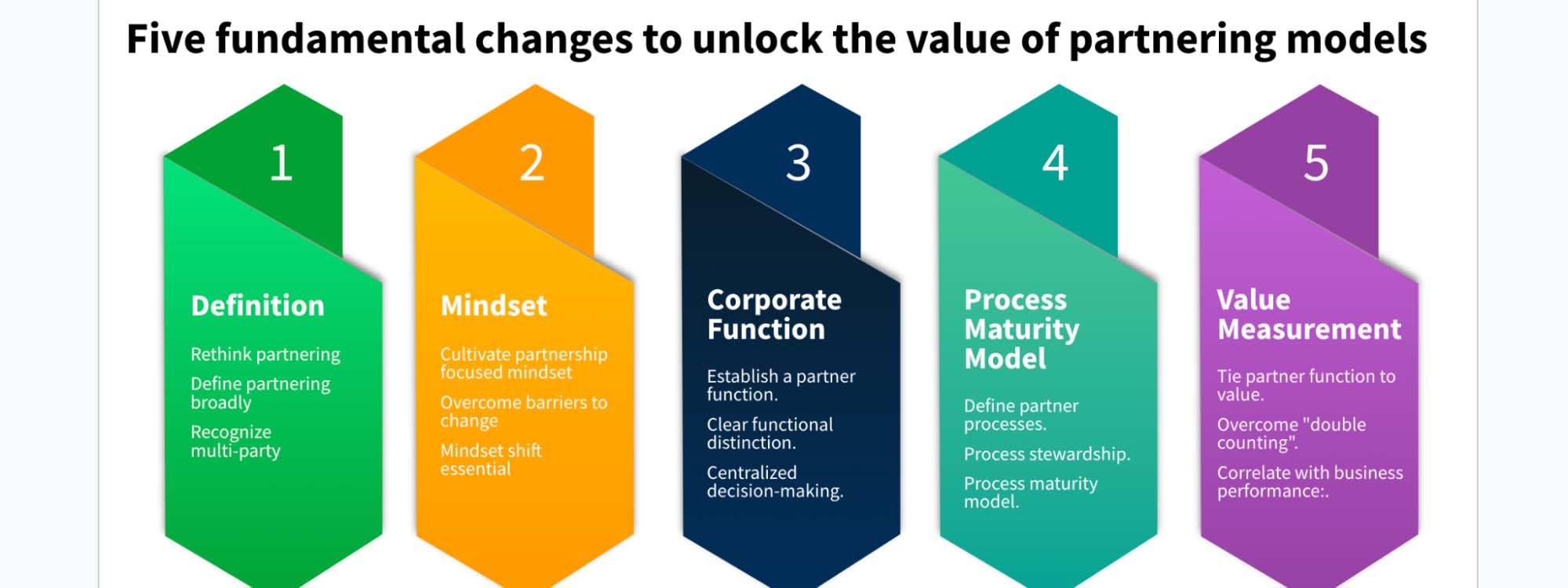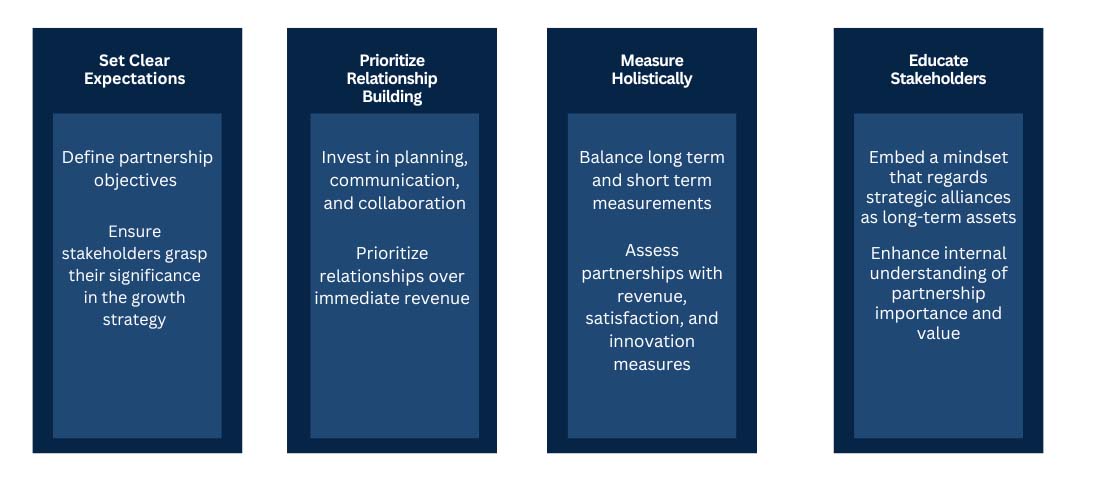
In today's dynamic business landscape, the significance of a Chief Partner Officer (CPO) in the realm of modern business ecosystems cannot be overstated. These ecosystems, comprising a web of partners, collaborators, and stakeholders, are no longer a mere concept but a fundamental aspect of contemporary business strategies. The CPO holds the key to extraordinary achievements for organizations.
Take, for instance, the transformation of Rapid7, a cybersecurity firm, which strategically pivoted towards a partner-led approach in its Go-To-Market (GTM) strategy. This shift yielded remarkable results, illustrating the profound impact of a well-executed ecosystem strategy on a company's growth and competitiveness.
The statistics are compelling: according to a recent EY study, “High-performing ecosystems drive on average 1.5 times the cost reduction, and generate 2.1 times the incremental revenue growth, compared to low-performing ecosystems.”
To unleash the full potential of ecosystems, organizations require more than just good intentions; they need a leadership structure that aligns with the essential motions for success. While Chief Marketing Officers (CMOs) and Chief Revenue Officers (CROs) guide other Go-To-Market (GTM) strategies, partnerships, as a fundamental growth approach, should be no exception.
In this blog, we delve into the pivotal role of CPOs, exploring the essential skills, systems, and processes necessary for those aspiring to lead within the ecosystem domain. Whether you aspire to be a Chief Partner Officer (CPO) or aim to enhance your organization's ecosystem strategy by appointing one, the insights presented here offer valuable guidance on unlocking the full potential of strategic partnerships.
We are covering:
- Understanding the Role of a Chief Partner Officer (CPO)
- What it Takes to be a Successful CPO
- Gaining Relevant Experience
- Challenges Faced by CPOs and How to Overcome Them
Understanding the Role of a Chief Partner Officer
A "Chief Partner Officer" (CPO) is a strategic executive role focused on managing and optimizing partnerships and collaborations within an organization's ecosystem. This includes developing partnership strategies, negotiating contracts, fostering innovation through collaborations, and overseeing co-selling and co-marketing motions. Plus, the CPO plays a crucial role in leveraging external relationships to drive growth and bolster the reputation of the company’s partner program.
Key responsibilities of the CPO might include:
- Ecosystem Strategy: Developing and refining the organization's ecosystem strategy to identify opportunities for collaboration and growth within the broader business environment.
- Partnership Management: Managing and nurturing relationships with key partners, including negotiations, contract management, and ongoing collaboration to create mutual value.
- Ecosystem Mapping: Identifying and evaluating potential ecosystem partners, including startups, industry disruptors, and established players, to determine their fit within the organization's strategic goals.
- Innovation and Co-creation: Promoting innovation through collaboration with ecosystem partners, including joint product development, research initiatives, and technology sharing.
- Regulatory and Compliance: Ensuring that the organization complies with relevant regulations and standards within its ecosystem while actively participating in shaping industry regulations.
- Risk Management: Assessing and mitigating risks associated with ecosystem partnerships, including cybersecurity, data privacy, and reputational risks.
- Internal Stakeholder Alignment: Collaborating closely with internal stakeholders, particularly marketing and sales executives, to ensure that all Go-To-Market (GTM) motions are fully aligned with partner strategy.
- Optimizing Partner Functions: Streamlining and expediting the integration of hyper-scaler marketplaces, optimize listings, and facilitate transactions, thereby maximizing the value of marketplace partnerships.
Much like the addition of a Chief Marketing Officer (CMO) or Chief Sales Officer (CSO) empowers a company to strengthen its Go-To-Market (GTM) strategies, having a CPO is equally instrumental in elevating the partner program's effectiveness.
By harnessing the expertise of a CPO, companies can cultivate a robust partner program, ultimately reaping the myriad benefits that stem from a well-structured and strategically managed network of partnerships. In other words, just as a sales team's potential is limited without a CSO to guide and expand their efforts, a partner program can only achieve its maximum potential with the guidance of a CPO.

Critical speed to value
Primarily, the Chief Partner Officer (CPO) plays an important role in expediting the delivery of value, which is essential in today's fast-paced business world. Speed-to-value is a top priority, and the CPO's involvement is vital because partnering is often the most efficient and sometimes the only way to introduce new value propositions rapidly. This strategic approach helps keep these offerings relevant and competitive in a constantly changing business environment.
Cloud marketplaces have transformed the way organizations buy and sell software solutions, presenting unparalleled opportunities for growth and success. However, the complexities and challenges associated with managing cloud marketplace listings can hinder organizations' ability to fully leverage this ecosystem.
Here are a few common challenges faced by companies:
- Significant technical and operational lift required to publish a transactable cloud marketplace listing.
- Delays in marketplace rollout and campaigns
- Missed marketplace deals and access to end customers’ cloud spend commitments
- Reduced visibility and support from cloud hyperscaler field teams on co-sell deals
Aligned incentives
With the growing adoption of shared capital risk/reward models, organizations need to ensure that their partnerships not only drive innovation and growth but also align with their financial and strategic objectives.
The CPO is instrumental in structuring partnership agreements in a way that ensures both parties share risks and rewards effectively. By doing so, these agreements not only enhance returns on capital investment but also provide opportunities to diversify capital risk. This means that when organizations collaborate with partners, they do so in a manner that aligns their mutual interests, fostering a more cooperative and mutually beneficial relationship.
In essence, the CPO ensures that partnerships are not only about innovation and growth but also about achieving a financial balance that is aligned with the organization's long-term sustainability and growth objectives. This approach helps organizations make the most out of their partnerships, delivering value not only in terms of new opportunities but also in a way that safeguards their financial health and strategic direction.
What it Takes to be a Successful CPO
At last month's Catalyst event in Denver, Greg Sarafin, Global Managing Partner - EY Alliance Ecosystem at EY shared that in order to achieve remarkable outcomes, a CPO must spearhead several key initiatives. Here are five pivotal areas that top CPOs focus on:

Partnership Definition Expansion:
A proficient CPO expands the traditional understanding of partnerships. They acknowledge that collaborations can take multiple forms and aren't limited to just two entities. By broadening the definition of partnerships, they tap into a myriad of partnership opportunities, promoting innovation, growth, and value across an expansive ecosystem.
Cultivating a Partnership Ethos:
A leading CPO works diligently to instill a partnership-centric ethos within the organization. They champion the importance of partnerships, leading by example, and showcasing their potential to spur innovation and growth. By fostering this shift in organizational perspective, they make the entity more adaptable and open to the ever-changing world of collaborations.
Establishing a Dedicated Partnership Function:
A visionary CPO emphasizes the need for a dedicated partnership management function within the corporate structure. They delineate clear boundaries between partnership activities and other organizational roles, ensuring clarity in roles and streamlined decision-making. By focusing on this distinct function, they enhance the management and optimization of partnerships, aligning them with the organization's broader objectives.
Implementing a Partnership Process Framework:
An astute CPO introduces a structured approach to partnership management. They lay down clear protocols for partner engagements, ensuring uniformity and efficiency. As stewards of this process framework, they oversee its ongoing refinement, ensuring the organization remains agile and responsive to changing business dynamics. This structured methodology not only boosts the effectiveness of partnerships but also elevates the organization's overall competitive stance in the market.
Prioritizing Value Measurement in Partnerships:
A forward-thinking CPO underscores the significance of measuring the value derived from partnerships. They ensure that the benefits and costs associated with partnerships are accurately represented, avoiding any overlaps. By correlating partnership activities with tangible business metrics, they offer a clear, data-backed view of the contributions partnerships make to the organization's success, facilitating informed decision-making and strategic enhancement of partner engagements.
How tech can help
Technology plays a pivotal role in scaling GTM strategies. Where would businesses be without indispensable tools such as Customer Relationship Management (CRM) systems? Similarly, in running a partner program, technology that could help securely transcend company boundaries is essential.
- Ecosystem Visibility and Partner Identification: Gain a comprehensive view of their partner ecosystem and identify potential partners aligned with their strategic goals.
- Collaboration Planning and Resource Allocation: Plan and execute joint initiatives efficiently by coordinating tasks, timelines, and budgets within WorkSpan.
- Performance Measurement and Analytics: Define KPIs, track collaboration success, and generate insightful reports to make data-driven decisions about your partnerships.
- Communication and Relationship Management: Create a central hub for communication, collaboration, and partner relationship management, fostering stronger partnerships.
- Security, Compliance, and Scalability: Ensure data security, compliance, and scalability as your ecosystem grows and adapts with WorkSpan's adaptable platform.
Gaining Relevant Experience
To become a Chief Partner Officer (CPO), individuals typically need a diverse set of skills and a wealth of relevant experience gained through various job titles and roles. We looked at the professional backgrounds of several industry leading CPOs to see what kinds of skills and experience have led them to their current roles. Here is what we found
Skills Common Among CPOs
Chief Partner Officers (CPOs) possess a distinctive skill set that sets them apart in the world of business leadership. Their collective expertise encompasses:
- Leadership and Executive Management: CPOs have typically held leadership positions and C-suite roles, demonstrating extensive experience in leading teams and organizations.
- Global Experience: These professionals have worked in various locations worldwide, showcasing their ability to operate in diverse global markets.
- Strategic Planning: CPOs are noted for their strategic thinking and planning abilities. They have played key roles in setting and executing global strategies to achieve business objectives.
- Business Development: Business development is a common thread among these professionals. They have a proven track record of driving business growth, whether through expanding partner ecosystems, growing revenues, or managing strategic relationships.
- Relationship Management: All of the profiles we looked at highlight relationship management as a key skill. They have managed and overseen relationships with partners, clients, and key accounts, underscoring their ability to build and maintain strategic alliances.
- Board Membership: Several of the CPOs we examined have served as board members in various organizations, indicating their influence and involvement in shaping industry trends and corporate governance.
- Specialized Industry Experience: Another commonality amongst CPOs is specific industry expertise, such as financial services and technology. This industry-specific knowledge allows them to provide valuable insights and strategies in their roles.
- Strategic Partnership Development: CPOs excel in creating and managing strategic partnerships and alliances to drive business growth.
- Marketing and Branding: Marketing skills, including demand generation, content marketing, and product marketing, help CPOs position partnerships effectively.
- Sales and Revenue Growth: Proficiency in driving revenue growth through partner channels is a key performance indicator for CPOs. These skills collectively define the unique capabilities that Chief Partner Officers bring to their roles, driving success and growth in the organizations they serve.
Common Job Titles and Roles Held by CPOs
Chief Partner Officers (CPOs) often come from diverse professional backgrounds and have held a range of pivotal roles in their careers. Some of the common job titles and roles that the CPOs we looked at have undertaken include:
- Global Managing Partner: This role often involves overseeing and managing strategic partnerships on a global scale, contributing to revenue growth and market expansion.
- Chief Operating Officer: CPOs who have served as Chief Operating Officers play a critical role in the operational aspects of partner organizations, ensuring efficient and effective partner engagement.
- Head of Global Ecosystem and Business Development: These professionals are responsible for leading global ecosystem development efforts and driving business growth through strategic partnerships.
- VP Global Partner Solutions: CPOs in this role lead commercial partner business and collaborate with partners to drive digital transformation, business growth, and profitability.
- VP, Worldwide Channels & Alliances: This role involves overseeing worldwide channel programs and alliances, focusing on partner relationship management and ecosystem expansion.
- Chief Marketing Officer: CPOs with a background in marketing take on this role to lead marketing efforts, including demand generation, content marketing, and product marketing, to promote partner solutions effectively.
Aspiring CPOs should focus on gaining experience in these roles and developing the skills mentioned above.
Building a career that involves strategic partnership development, business leadership, marketing, and global ecosystem management can pave the way for a successful transition into the role of a Chief Partner Officer.
Additionally, active involvement in partnership-focused organizations, such as Partnership Leaders, can provide valuable opportunities to network with peers, learn partnering best practices, and gain insights into the world of partnership management, further preparing individuals to advance to the top spot as a Chief Partner Officer.
Chief Partner Officers Paving the Way
Below are some outstanding examples of Chief Partner Officers already in their roles and paving the way for other partnership leaders and professionals. These leaders have been incredibly impactful driving change and leading their organizations to new heights by embracing an ecosystem mindset and harnessing the collective energy of their partner ecosystems.
.png)
And as mentioned above, these Chief Partner Officers all came from many different backgrounds to their current role leading the partnerships function for their companies.
For instance, Greg Sarafin of EY, Karl Fahrbach of SAP, and Kevin Ichpurani of Google have each been deeply involved leading partnerships and partner organizations for many years growing in experience and depth focused on partnering.
On the other hand, Nicole Dezen at Microsoft and Jason Eichenholz at Wipro progressed through sales roles to their current positions and Ruba Borno of AWS has an extensive background leading customer experience at Cisco and consulting at BCG.
Finally, Bader Hamdan comes from an extensive diverse career building and leading ecosystem partnerships and currently CPO at a GenAI startup, Vectara. While my own background in numerous marketing leadership roles led me to my current CPO role at WorkSpan.
This shows that the journey to becoming a CPO is varied, and individuals from diverse professional backgrounds can very well secure the top partnership position.
Challenges Faced by CPOs and How to Overcome Them
A Chief Partner Officer (CPO is a pivotal leadership role entrusted with steering an organization's strategic partnerships and alliances. However, with great responsibility comes an array of challenges, and it's crucial to navigate them effectively to achieve sustained success. Among these challenges, three fundamental aspects stand out: balancing short-term gains with long-term partnership goals, navigating conflicts of interest in partnerships, and ensuring alignment between partner goals and company objectives.
Balancing Short-term Gains with Long-term Partnership Goals
One of the primary challenges faced by CPOs is striking the right balance between immediate results and long-term partnership objectives. The pressure to demonstrate quick wins, generate revenue, and meet quarterly targets can sometimes conflict with the need to nurture and build enduring partnerships. To overcome this challenge:
- Set Clear Expectations: Clearly define short-term and long-term partnership objectives. Ensure that stakeholders understand the importance of both and how they contribute to the overall growth strategy.
- Prioritize Relationship Building: Allocate resources to relationship-building activities, such as joint planning sessions, regular communication, and collaboration workshops. These investments may not yield immediate revenue but are essential for long-term success.
- Measure Holistically: Develop a balanced scorecard that includes short-term metrics (e.g., revenue generated) and long-term metrics (e.g., partner satisfaction, innovation pipeline). Use this comprehensive approach to evaluate partnership performance.
- Educate Stakeholders: Educate internal teams, including sales and marketing, about the value of long-term partnerships. Encourage a culture that values strategic alliances as assets that appreciate over time.

Navigating Conflicts of Interest in Partnerships
Partnerships often involve organizations with different interests, and conflicts can arise, threatening the partnership's stability. CPOs must adeptly handle these conflicts to ensure partnership longevity:
- Transparency and Communication: Foster an environment of open communication. Encourage partners to voice concerns or conflicts early on, enabling timely resolution.
- Mediation and Conflict Resolution: Establish clear conflict resolution procedures. Designate a neutral third party or mediator to help facilitate discussions and find mutually beneficial solutions.
- Aligned Interests: Ensure that partnership agreements clearly outline shared objectives and interests. When conflicts arise, refer back to these agreements to realign efforts.
- Collaborative Problem-Solving: Encourage partners to view conflicts as opportunities for growth. Collaboratively seek solutions that address the root causes and strengthen the partnership.
Ensuring Alignment Between Partner Goals and Company Objectives
Another critical challenge is maintaining alignment between partner goals and your organization's broader strategic objectives. Misalignment can lead to wasted resources and lost opportunities. To mitigate this challenge:
- Regular Strategy Reviews: Conduct periodic reviews of both partner and company strategies. Ensure that they remain compatible and make adjustments as necessary.
- KPI Alignment: Align key performance indicators (KPIs) between partners and your organization. Ensure that each party's success metrics contribute to the achievement of common goals.
- Cross-functional Collaboration: Facilitate collaboration between different departments within your organization to ensure that partner goals align with various business units' objectives.
- Regular Partner Check-Ins: Maintain a continuous dialogue with partners. Regularly assess their evolving goals and adjust your collaborative efforts accordingly.
- Managing Internal Partner Teams with Differing Goals: Drive alignment among various internal partner teams, including reseller/channel, technology, strategic, and agency partners. Foster clear communication and coordination to ensure that each partner team understands and contributes to the overarching strategic objectives of the organization.

Wrapping Up
The role of Chief Partner Officer (CPO) has become indispensable in today's business landscape, driven by the rise of ecosystems. CPOs play a pivotal role in fostering successful partnerships, contributing to cost reduction, revenue growth, and innovation.
Aspiring CPOs should focus on developing a partnership-focused mindset, establishing partnership management as a distinct corporate function, and adopting systematic approaches to partnership operations. Leveraging technology, such as WorkSpan's Co-Sell Platform, can be your Platform for the Chief Partner Officer to streamline partner programs, scale your partner business, and measure it all with a dashboard for success.
While promising, the path to Chief Partner Officer is not without challenges. CPOs must balance short-term gains with long-term goals, navigate conflicts of interest, and ensure alignment between partner and company objectives.
In this evolving business landscape, CPOs are pivotal in harnessing the full potential of strategic partnerships, offering organizations a competitive edge in the ecosystem-driven future.
Want to learn more? Check out the Chief Partnership Officer report we collaborated on with Partnership Leaders at ChiefPartnershipOfficer.com.

Heading
Heading 1
Heading 2
Heading 3
Heading 4
Heading 5
Heading 6
Lorem ipsum dolor sit amet, consectetur adipiscing elit, sed do eiusmod tempor incididunt ut labore et dolore magna aliqua. Ut enim ad minim veniam, quis nostrud exercitation ullamco laboris nisi ut aliquip ex ea commodo consequat. Duis aute irure dolor in reprehenderit in voluptate velit esse cillum dolore eu fugiat nulla pariatur.
Block quote
Ordered list
- Item 1
- Item 2
- Item 3
Unordered list
- Item A
- Item B
- Item C
Bold text
Emphasis
Superscript
Subscript





.png)